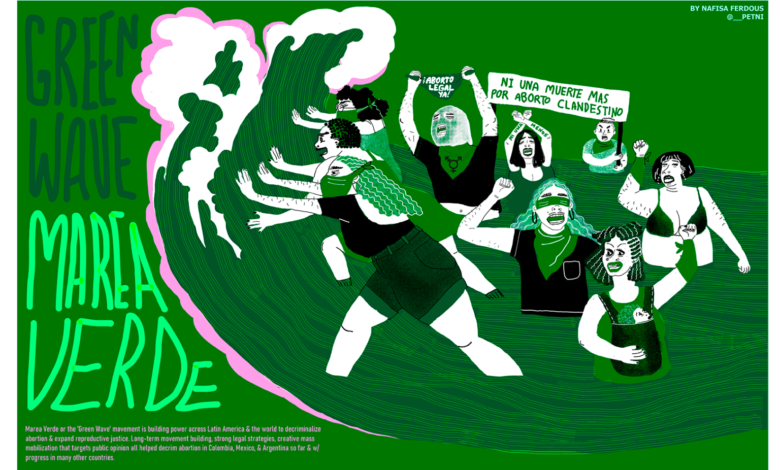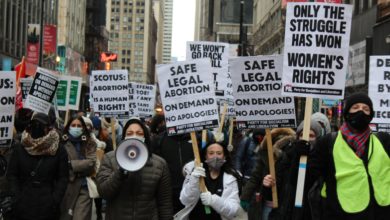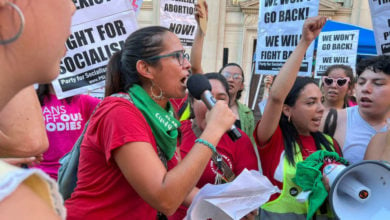
Reprinted from Breaking the Chains.
The Supreme Court’s decision to strike down Roe v. Wade in June was not only unpopular in the United States, with over 72% of people opposed to the ruling, but also went against the overwhelming worldwide trend toward increasing reproductive freedoms. Latin America specifically has seen some of the most inspiring examples of victories for reproductive justice in recent years, all of which were made possible through movements organized by working-class women. The resounding success of organizing efforts in Argentina, Colombia, Mexico and other countries has inspired activists in the United States and has strengthened the network of solidarity that has existed between Latin American abortion rights organizers and their US counterparts for decades.
According to the Center for Reproductive Rights, 53 countries have enacted laws that expand access to abortion since 1994. The United States is only the fourth country to have reduced access to abortion within this same time period, signaling a concerted push against the progressive tide sweeping other parts of the world. In Latin America, the movement that has made this trend possible has the fitting name of “La Marea Verde,” or “The Green Tide.” This name comes from the iconic pañuelo verde, or green handkerchief which has become the symbol for the Latin American reproductive rights movement. The Green Tide has now reached the United States, with large numbers of protesters sporting the color green in abortion rights protests across the U.S.
The pañuelo verde was first adopted by the National Campaign for Legal, Safe, and Free Abortion in Argentina, which was founded in 2003. The Campaign presented a bill for the legalization of abortion to the Argentine Congress in 2008; the bill was soundly defeated but began the long road towards a legal victory. Similar bills were presented and subsequently rejected about every two years. The turning point in the movement didn’t occur until the creation of the “Ni Una Menos,” or “Not One Less,” movement, which rose to the forefront in Argentina after a series of brutal murders of women and girls sparked nationwide protests in the mid-2010s. One of the victims, Chiara Páez, was only 14 years old and was pregnant. The massive mobilizations in the streets against machista violence helped to popularize support for a wide range of women’s rights struggles and highlighted the connections between the fight against femicide and the fight for reproductive rights.
These and subsequent protests tied to the Ni Una Menos and Marea Verde movements also emphasize that issues like femicide and unsafe clandestine abortions affect poor and working-class women the most. One popular chant at the protests in support of abortion rights has been “Las ricas abortan, las pobres mueren,” or “The rich abort, the poor die.” The movement achieved a tremendous victory when the Argentine Senate passed a bill legalizing abortion up to 14 weeks of pregnancy on December 30, 2020.
This victory in Argentina strengthened many other movements beyond its borders. In Mexico, abortion was unanimously decriminalized by the Supreme Court in September 2021. This followed a strong militant Marea Verde movement of Mexico’s own. For years it has been a common sight for city streets to turn green with pañuelos verdes throughout the country on September 28 (International Safe Abortion Day), March 8 (International Women’s Day), and beyond. The decriminalization of abortion in Mexico set an important legal precedent and marked a tremendous milestone for the women’s liberation movement in Latin America’s second most populous country.
Before Mexico decriminalized abortion nationwide, networks of activists worked to provide access to safe abortions by mailing abortion medication and providing practical guidance and emotional support over the phone. After abortion was decriminalized in Mexico City in 2007, there was a long drought of legal advances. Social media played a huge role in invigorating the movement and providing access to medicated abortions. For example, the organization Aborto Legal México created a particularly impactful Facebook group in 2018. Members of the group shared scientific information about abortion, discussed news of the movement in Argentina and allowed women to organize themselves into coalitions based on geography. This group also became a resource for people seeking information about and support in accessing medication abortion. The group estimated that from 2018 to 2020, they assisted with 1,000 medical abortions in Mexico and other countries like Perú, El Salvador, Honduras, Chile and Argentina.
Groups like Aborto Legal México are also standing in solidarity with women in the United States as our reproductive rights are stripped away. In the wake of the Texas abortion ban, one organization called Las Libres committed to help women who need abortions travel into Mexico to have their procedures, and bring medication abortion into the United States or send them by mail. Another organization, I Need an Abortion, based in the city of Monterrey, has accompanied between five and seven women from the United States per week in the wake of the Roe decision. This group also provides virtual help after mailing medication abortion to the homes of those who request it. There are more than 30 different Mexican organizations providing support to people who need abortions in the United States. This level of international cooperation, along with the inspiration that the Mexican and Latin American abortion rights movements at large provide, shows that we have much more uniting than separating us–we are all together in the fight for women’s liberation. El pueblo, unido, jamás será vencido!





